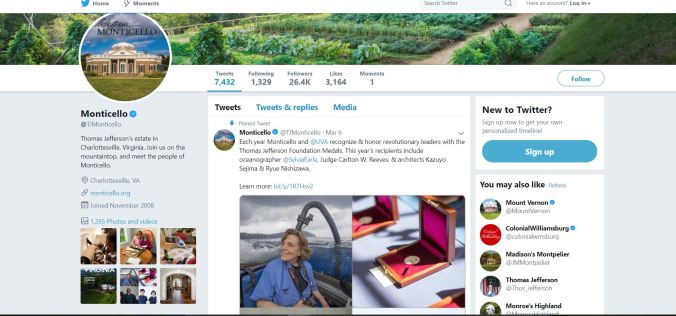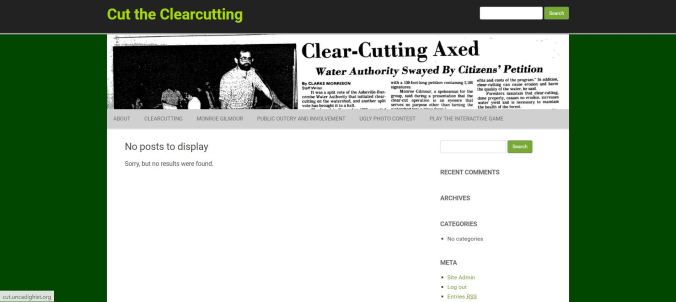Looking back ten years ago, I never thought cell phones could have the power to connect individuals across the world through social media platforms. Facebook was nothing like it is today, and concerns over improper access to data through private agencies like Cambridge Analytica probably never crossed most users’ minds. Many simply used it to share pictures from their vacations or those from family reunions and “big moments” in life (graduations, weddings, confirmations, bar mitzvahs, etc.) Myspace (yes, MySpace) was still somewhat relevant, even being featured in Horton Hears a Who! Twitter timelines lacked the elegance and polish users take for granted today, while Instagram would not even exist until 2010.

Would Thomas Jefferson have ever thought his estate would be advertised on such a site like Twitter? What a difference 200 years makes!
Times have changed, however, and social media has become an everyday part of our lives. It even affects those who do not have a Facebook or Twitter, like me, and draws us into a world within our own. Canadian educator and pedagogue Dr. Bonnie Stewart identifies the key “selves” of networked publics– ways our identities on the Internet reach or interact with others. According to Stewart, there are six of these selves:
1. The Public Self– based on our connections with the public
2. The Quantified Self – based on numbers and figures we can quantify in our online presences (e.g., “retweets” or “likes”)
3. The Participatory Self- based on our participation and involvement in public networks
4. The Asynchronous Self – based on how much interruption we experience in our connections
5. The Polysocial Self – based on how far (or how little!) our online profile strays from our human nature
6. The Branded Self – based on the “market worth” of our online identities.
Depending on the type of public history (or “applicable history”) in which we engage, we definitely exhibit Selves 1 and 3. Carson, Amanda, and I can certainly attest to this. Our public selves have already connected with Monroe Gilmour through email, while our participatory selves are viewing the websites of other classmates and commenting on their efforts.
Larger museums, universities, and historic sites with greater capital than our HIST 374 class should devote extra time to developing Selves 2 and 6 (the Quantified and Branded Selves.) That is not to say we should not too. However, our concepts of metrics and “brands” will be completely different than a private or nonprofit’s, and naturally less will be at stake.

All these “shells” need are some meat and cheese.
Within the humanities, technology has the capability to allow our “selves” to interact with the world. It can also tear down “walls” which prevent this interaction.The walls between those in society who seek tangible, quantifiable results rendered by technology and humanists who seek to make broader, more abstract conceptions of life seem to have fallen. Digital humanities and history courses – though relatively recent – have grown in years, demonstrating humanists and historians can exist and remain relevant in the digital age. Museums and universities across the globe now emphasize interactivity, including virtual tours, scheduling software, and relevant maps users can explore on their websites. Dr. Pearson could provide far more links than I could, but I will give the link to the Virtual Tour of George Washington’s Mount Vernon I remember from her HIST 250 class. I strongly urge you to visit it; the experience truly is as close as you can get to visiting the estate.
Within the humanities, technology has the capability to allow our “selves” to interact with the world. It can also tear down “walls” which prevent this interaction.
I can say working on “Cut the Clearcutting” has affected my digital identity by expanding my public and participatory selves to build a branded self. Of course, my own brand is not quite as “high stakes” as celebrities, politicians, business leaders, or more high-profile public figures. Nevertheless, the fact future employers, family members, friends, and colleagues can see the website my team and I have completed is indeed reassuring. It demonstrates I am more than just “Spencer Andersen – history major” or “Spencer Andersen – paralegal” (my current career plan). It reveals other sides of my identity, including interest in matters of local history such as the anti-clearcutting movements of the 1980s.
Assuming I maintain the site regularly, this will continue to be the case years after I complete the class. Obviously, this may not be the reality – I may move or be too busy to do so. Nevertheless, I will have established a digital identity, connected to others, and worked with teammates on a complex but worthwhile project – all valuable life skills in the years to come.
So far, I have added the basic links for Carson and Amanda as “shells” they can edit. All that is left is for them to add their “fillings” to the “shells,” neatly and conveniently defined through our contract. I wish them both a great spring break, and look forward to making Cut the Clearcutting a public and participatory site.